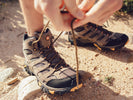
5 Tips For Finding The Best Hiking Boots For You
, by Ed Stone, 4 min reading time

, by Ed Stone, 4 min reading time
You came to the right place! We’ll walk you through five tips to help you find the right hiker.
Hiking boots can vary widely, but they all provide better traction, more flexibility, and are lighter weight than your typical work boot or shoe. Hiking footwear can take you from the deserts of Southern California to the cloud forests of the Amazon, but you shouldn’t use the same boot for each trip. The first step to finding the right fit—whether you’re shopping for men’s hiking boots or women’s hiking boots—is to determine the conditions in which you’ll be wearing the boot.
Will you be…
Your hiking conditions will dictate how heavy-duty of a hiker you need and whether you need extra bells and whistles like waterproofing.
Heavy packs can take a toll on even the best hikers. Sometimes, it’s impossible to pack lightly for your hike. That’s where your hiking footwear comes in. If you’re hiking with a heavy pack, we recommend choosing a stiffer sole and possibly taller boot height.
Why? The stiffer sole will provide more support for the extra weight, and the extra height will help protect your ankle while you’re top-heavy. Just remember, heavier boots take longer to break in. Plan accordingly!
No one wants wet feet during a long, grueling hike. Not only is it uncomfortable, it can be dangerous too. Waterproof boots are your first line of defense against moisture—and these come in several forms.
DIY:=Products like SnoSeal can be applied to hiking boots constructed using quality, all-leather uppers. If you’re up for it, DIY applications can work well and preserve your leather, but they may be slightly less breathable than other options.
Seam Sealed Construction: Manufacturers who use high-quality, water-resistant leather may seal the seams from the inside to keep water out. These boots provide good breathability and moderate water protection, but they aren’t as waterproof as a bootie liner. You may also need to re-apply the waterproof treatment after some use.
Waterproof Bootie Liner: Liners are the best waterproof protection you can get. Combine a liner with waterproof leather for the best protection. But make sure to wear wick-dry socks—these liners don’t breathe as well as non-bootie waterproof boots.
For cold weather hikes, it may be best to grab a boot that’s insulated. An insulated boot can help you climb glaciers and snowy peaks. A good pair of wool socks is also a great addition to your cold-weather gear.
Once you’ve answered all these questions, you can easily narrow down your options to find the right hiking boot for your next trek. But we’ve got a few more tips and tricks to help you get the most out of your hiking footwear:
Skip leather linings—they absorb moisture and are slow to dry.
Break your boot in thoroughly—while wearing your hiking socks—before your hike.
Wear high-quality, moisture-wicking socks. Avoid cotton except for light hiking purposes as they hold too much water.
Don’t let uncomfortable hiking boots keep you from getting out there this summer. Come visit any of our Boot World locations to meet with a trained hiking shoe expert for guidance--and check out our guide to finding the right fit before you drop by.
Ed Stone brings over 45 years of footwear knowledge and passion to his role as President of Boot World, a family-owned company and an industry leader in safety and occupational footwear. A second generation "shoe dog” Ed's footwear knowledge is unparalleled, serving as an informal advisor for some of the worlds largest footwear brands including Wolverine, Timberland PRO, and Reebok Works.
A lifelong Southern California resident, and ardent conservationist, Ed enjoys hiking and open water swimming.